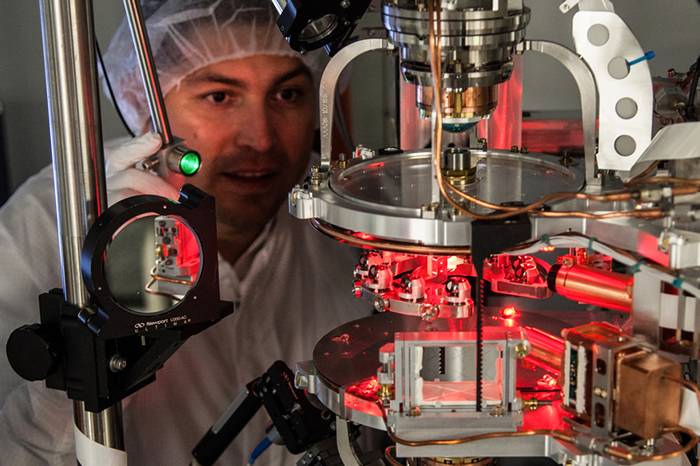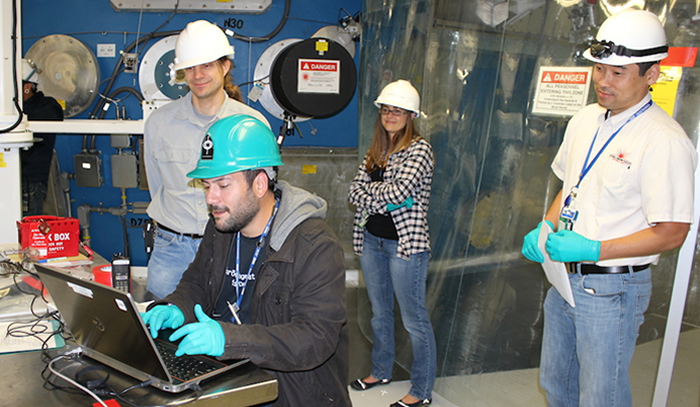Efficiency Improvements - 2016
July
New Target Alignment Sensor Installed on NIF
For successful ignition experiments, NIF’s 192 laser beams and targets must be aligned within a tolerance of about 20 microns—about one-fifth the diameter of an average human hair. Achieving this level of precision requires many fine-tuned calibrations and correlations between the laser beams and the target.
A key instrument for achieving this level of precision, a new target alignment sensor, or TAS, was installed on NIF in July that should go a long way toward streamlining the process.
The TAS is a precision optical device inserted into the Target Chamber center (TCC) by the target alignment sensor positioner (TASPos) to facilitate both beam and target alignment. The latest version, dubbed TAS4, is a significant enhancement over previous versions for one primary reason—it can operate in conjunction with NIF’s new Advanced Tracking Laser Alignment System (ATLAS).
 Target Alignment Sensor (TAS) Systems Manager Edwin Casco uses collimated light from an eye-safe lamp to verify alignment and clearances inside the new TAS4 target alignment sensor. The red light is from light-emitting diodes used to illuminate NIF targets during alignment. Credit: James Pryatel
Target Alignment Sensor (TAS) Systems Manager Edwin Casco uses collimated light from an eye-safe lamp to verify alignment and clearances inside the new TAS4 target alignment sensor. The red light is from light-emitting diodes used to illuminate NIF targets during alignment. Credit: James Pryatel The ATLAS laser tracker sends collimated laser beams across the Target Chamber and uses optical systems to provide three-dimensional coordinate measurements of all of the NIF positioners, diagnostic instrument manipulators (DIMs) and static x-ray imagers. The tracker incorporates a servo system to steer the laser beam so that it tracks retroreflectors, known as corner cubes, on the DIM snouts. Low-power laser light reflects off the optical targets and back to the tracker; the returned signal is then analyzed for position to locate the retroreflecting target in 3D space.
“What’s special about TAS4 is that we have ATLAS retroreflectors on it,” said Target and Beam Alignment System Manager Shannon Ayers. “The whole reason for putting TAS4 in was so that we can register ATLAS to TAS, which will give us a wholly integrated alignment system.
“It was a big effort to get the TAS installed,” she said. “We’re going through ATLAS commissioning right now, so this is a good time to get the TAS in. It should be able to align to the same tolerances (as previous TASs) and meet the same system requirements.”
Along with aligning the target with the laser beams, Ayers said the TAS is responsible for ensuring that the target is in the center of the Target Chamber, so it can be seen by the diagnostics in ports surrounding the chamber. “DIMs will actively repoint to wherever you define TCC to be,” she said, “but you also have fixed diagnostics, like DIXI (the Dilation X-ray Imager), and line-of-sight diagnostics like neutron time-of-flight sensors, and you don’t dynamically adjust those; so you have to be within a reasonable distance of TCC.”
The current process for aligning NIF targets and diagnostics is a complex dance involving an alphabet-soup of systems and instruments: along with TAS and the DIMs, there’s the CCRS (Chamber Center Reference System), the OPAS (Opposed Port Alignment System), and the CIVS (Chamber Interior Viewing System). The process can take an Alignment Operator up to an hour to prepare for a shot. “Eventually ATLAS will do the same thing OPAS and CIVS do,” Ayers said. “It registers to the TAS, the TAS registers to CCRS, which defines TCC, and you can align your DIMs using the ATLAS.”
ATLAS also will be needed in order for NIF’s new Target and Diagnostic Manipulator (TANDM), a combination diagnostic instrument manipulator and target positioner, to be used to position diagnostics. Development of both ATLAS and TANDM were the result of a shot-rate improvement effort launched in 2014. Along with saving operator time, ATLAS provides additional flexibility in the sequence of alignment activities and improves the repeatability and accuracy with which instruments can be aligned.
Ayers said all three previous TASs will be upgraded to ATLAS compatibility and calibrated so they can serve as backups to TAS4.
 (Above) The new ATLAS-compatible TAS4 target alignment sensor installed in the target alignment sensor positioner (TASPos) with an installed calibration target. Credit: Shannon Ayers (Below) Alignment team members (from left) Tom Zobrist, John Vickers, Shannon Ayers, and Jared Okui evaluate TAS4 performance during calibration tests. Credit: Edwin Casco
(Above) The new ATLAS-compatible TAS4 target alignment sensor installed in the target alignment sensor positioner (TASPos) with an installed calibration target. Credit: Shannon Ayers (Below) Alignment team members (from left) Tom Zobrist, John Vickers, Shannon Ayers, and Jared Okui evaluate TAS4 performance during calibration tests. Credit: Edwin Casco
Once the TAS is installed and calibrated on the TASPos, the actual alignment activities take place in the NIF Control Room. “All the magic happens in the Control Room at the Alignment Operator consoles,” Ayers said. “Those are very talented individuals up there in Alignment Operations. Without those Alignment Operators doing their jobs, we’d never be successful.”
NIF alignment “is a really neat, intricate system,” Ayers said. “Even as much as I know about it, it still amazes me.”



